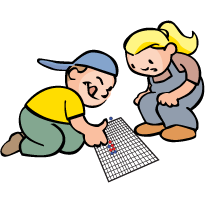Boston Children's Museum
308 Congress Street, Boston, MA 02210
617-426-6500
© Boston Children’s Museum 2025
Website Design by JackrabbitCultural understanding is easier for children when it is grounded in commonalities. By learning and playing games that children in different cultures also play, kids can come to discover that people from different parts of the world are not as different as they might seem. And while they are discovering this, they will also be developing math skills like visualization, pattern recognition, logical deduction and counting.
Gomoku is a 2-player game that is traditionally played on a Go board (Go is another traditional Japanese game that originated in China) with the Go pieces. These pieces are black and white, with one player using the black pieces and the other player using the white. In this activity, many different things can be used as the playing pieces as long as it is easy to tell the difference between them. Glass vase gems work best. They can be found at any craft supply store. You should look for gems that are 3/4″ – 1″ (18 – 25 mm) wide. See the Materials section at the end of this guide to find an online supplier. You will need 50 gems per student, and should get 2 clearly different colors. These gems are often sold in 1-pound bags, and there are about 100 gems per pound.
An alternative to the gems could be beans (as long as they are clearly different colors), checkers, M&Ms (though children will be tempted to eat them!)…anything that is between 1/2-inch and 1-inch wide. You could even play Gomoku as a pencil and paper game, with one child playing Xs and one Os (like Tic Tac Toe), though the down side to this is that you will need a new piece of graph paper for each game.
Make a Gomoku board yourself following the directions below. If you have a chance, find someone to play the game with you so that you understand the rules.

Ask your students if they have ever played Tic Tac Toe or Connect Four. What is the goal of these games? Are these games easy or hard? After this brief discussion, ask your students if they have ever heard of the country of Japan. Can they find it on a map? Have a volunteer locate Japan on a world map. What kinds of games do your students think kids play in Japan? Tell your students that they will be making a game that children in Japan sometimes play, and that it is a lot like Tic-Tac-Toe and Connect Four.
Make and play your own Gomoku game.
Divide your students into teams of 2 for this activity.
Using a piece of graph paper and a marker, your students should make their game board by drawing an 8″ X 8″, 9″ X 9″ or (with large enough paper, or 2 pieces taped together) a 15″ X 15″ grid. Lines should by 1 inch apart. Here is what a 6 X 6 grid would look like with some game pieces on it (See Figure 1).
Object of the game:
The object of the game is to lay 5 pieces in a row vertically, horizontally or diagonally while keeping your opponent from doing the same.
How to start:
One child should place a game piece in a closed fist and ask the other child to guess which hand it is in. If the guesser is correct, he or she begins the game using the color of the piece that was in his or her opponent’s fist. If he or she guesses incorrectly, the other child starts.
How to play:
Players take turns placing one piece at a time on the board. Pieces are placed where lines cross. The player who goes first may place their game piece anywhere on the board. The second player then places a piece, and play continues until either player has 5 pieces in a row vertically, horizontally or diagonally.
After each team has played once, gather your students together to talk about what they have discovered. Is this a hard or easy game? Did anyone discover any strategies for playing well? Some players may discover that if you get 4 pieces in a row with none of your opponent’s pieces at either end, then you are guaranteed to win. Try to have them share this strategy with the group, or ask if anyone noticed this situation and what the result was. This discussion should last no more than 5 minutes.
Have them return to playing the game. After playing a few times, they can switch partners if they would like to try playing with someone else.